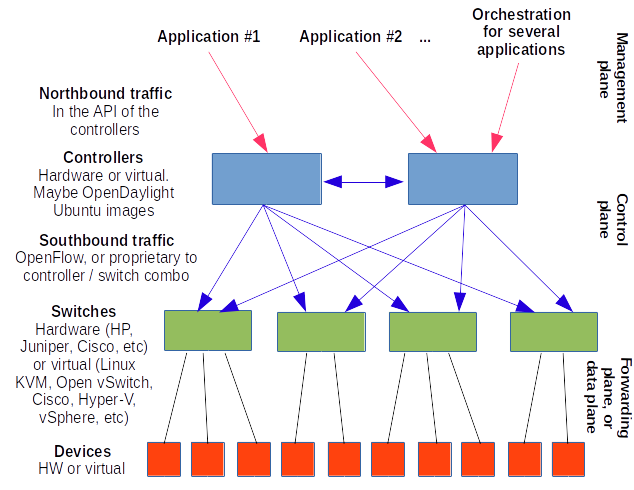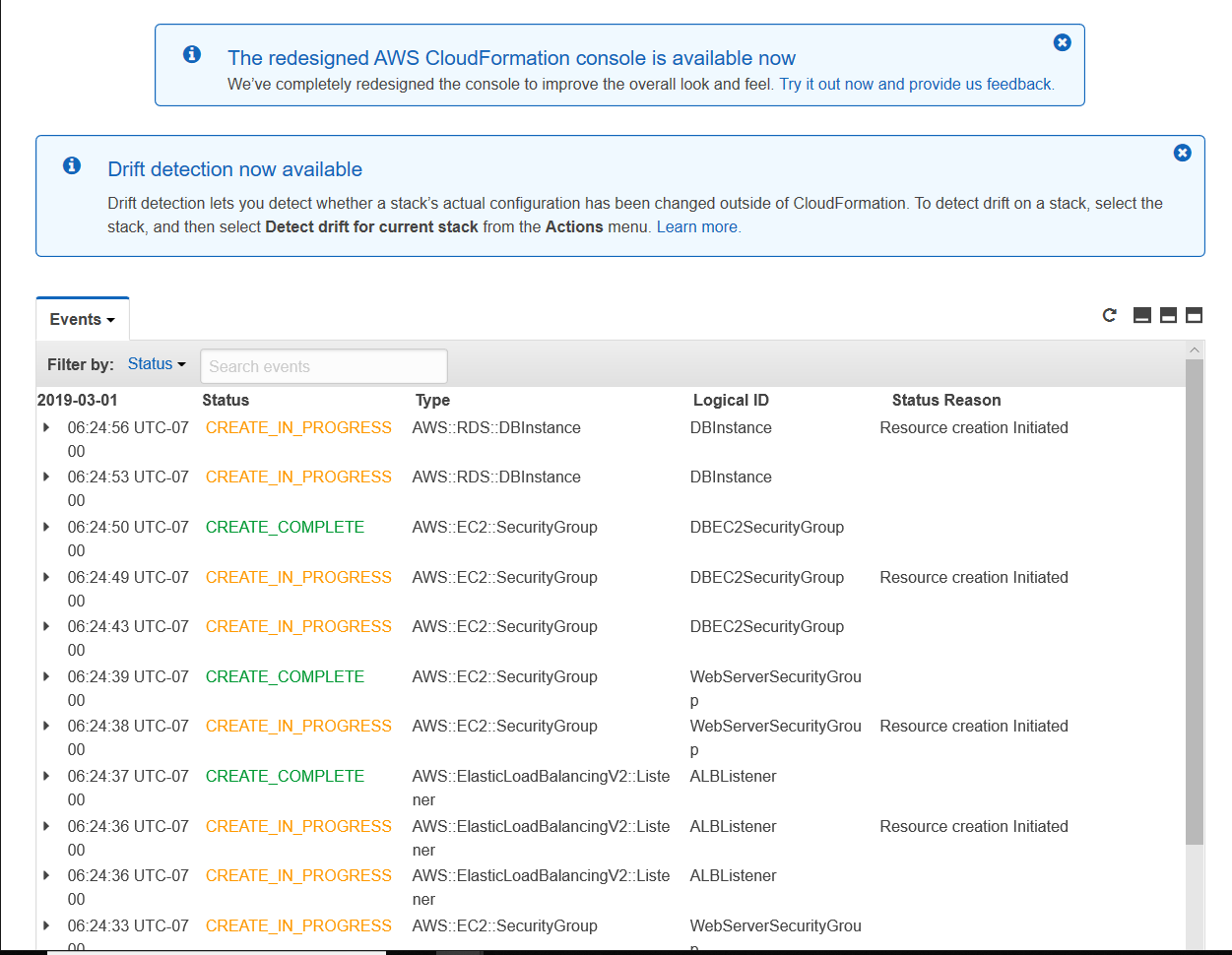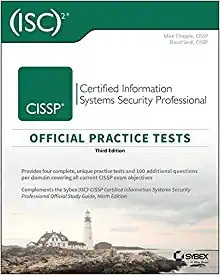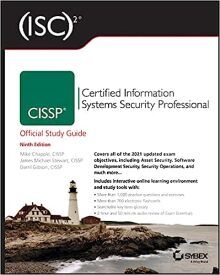
CISSP Domain 4 — Communication and Network Security
Domain 4 — Communication and Network Security
Yes, you need to know the OSI 7-layer model, or at least some of it. This should suffice:
| Layer | Device making decisions at this layer | |
| 7 6 5 |
Application Jobs software programs do |
ALG, AV, Spam filter, DLP, WAF, etc |
| 4 | Transport UDP: Messages to numbered ports TCP: Connections to numbered ports |
Firewall |
| 3 | Network Relay packets hop by hop to anywhere by IP address: [netid|hostid] |
Router |
| 2 | Data Link Send frames to HW/MAC addresses |
Switch |
| 1 | Physical Send and receive 0 vs 1 bits |
Repeater (point-to-point link) or hub (star) |
Ancient History
This domain contains more ancient history than any other.
Network topologies: Know about Bus, Tree, and Ring in addition to the modern Star and impractical Mesh.
Collisions: Shouldn't be an issue with Ethernet switches (unless negotiation failed), but they want you to know about CSMA/CD.
FDDI: It was an attractive campus or metropolitan-area 100 Mbps backbone technology in the early to mid 1990s. Know that it has dual rings, so it can fail to a single ring if a link is cut. It can use copper or fiber.
Unexpected Layer 1 details
This wording is subtle, but know it:
- Concentrators multiplex connected devices into one signal for transmission.
- Multiplexors combine multiple signals into one signal for transmission.
Fiber types:
- Single mode: greater transmission distance
- Multimode: typically up to 400 meters
- POF or Plastic Optical Fiber: significantly shorter range, about 100 meters
Fibre Channel over Ethernet or FCoE: It's a high-speed serial interface using fiber or copper.
DSL:
- ADSL or Asymmetric Digital Subscriber Line: downstream transmission rates are much greater than upstream, typically up to 8 Mbps vs 384 kbps.
- VDSL or Very High Bit Rate DSL: much higher rates, maybe 52 Mbps downstream and 2 Mbps upstream, but limited to a much shorter distance from the CO or Central Office to the customer.
Cable modems: Know that they use the DOCSIS protocols.
BPL or Broadband over Powerline: This technology hasn't really caught on, due to the severe radio interference problems it causes. But know that it exists.
WiFi range extenders: Know that these exist.
Bluetooth: 802.15. Use Bluetooth 4.x and above, with FIPS approved AES.
Satellite: Useful for remote or sparsely populated areas.
Mobile telephony:
- CDMA or Code-Division Multiple Access: Signal is multiplied by a higher-speed bit stream, this is like DS-SS or Direct-Sequence Spread Spectrum.
- GSM or Global System for Mobiles: Calls get a channel and a time slot, so both time and frequency multiplexing.
- Generations: 1G, 2G, etc., just know that it's evolving, bandwidth is growing, and service is becoming more IP-based.
Unexpected Layer 2 details
Know a little about MPLS or Multiprotocol Label Switching: it's a WAN protocol, the first device inserts a label into the frame header, that's used for fast forwarding decisions at all subsequent hops. It lets you do traffic engineering, but it's being replaced by SD-WAN.
You might use PPPoE encapsulation on VPNs today.
Unexpected Layer 3 details
Know that the default gateway or default router might be called the gateway of last resort.
Ping of Death: This sounds ancient, it was an issue in the 1990s, but it was a Windows vulnerability again in 2013.
Unexpected Layer 4 details
Know that the Well-Known Ports are 0-1023.
Unexpected Layer 5 details
PPTP is used to encapsulate and tunnel, as over a VPN. (although its attempt at cryptography is flawed and shouldn't be used)
The modern way to run a VPN is to use L2TP to manage the tunnel and IPsec to encrypt the traffic.
RPC or Remote Procedure Call protocol: Does what it says.
Unexpected Layer 6 details
Systems use ASCII to represent Unicode.
For example, ASCII Щ within an
HTML file represents Unicode character 0x0429,
the Cyrillic letter Щ.
UTF-8 is a character encoding that lets you represent arbitrary Unicode alphabets directly.
Browsers use Unicode internally, and convert other encodings into Unicode. So do search engines.
MP3 or MPEG-1 Audio Layer 3 is a standard audio encoding and compression algorithm. WAVE is another audio encoding standard.
Unexpected Layer 7 details
Know about X11 and the ancient commands
rlogin, rcp, rsh,
and ftp.
You should have replaced them some time ago with
the SSH versions: ssh, scp,
and sftp.
Screen scrapers have been useful to automatically interact with mainframes over TN3270 or similarly old technology.
Application Protocols
DNS: Know that you need A, NS, PTR, and MX records. More importantly, know about DNSSEC. I would expect it to be the most common network protocol question topic.
There are DNS resource records for public keys (DNSKEY) and digital signatures (RRSIG). With DNSSEC you have reason to believe that a response is correct, including when the response says that the requested record doesn't exist. My server is in the Google Compute Cloud, and Google's DNS service includes DNSSEC. Notice the RRSIG and DNSKEY records below.
RRSIG records are digital signatures over the indicated preceding record: "RRSIG A" is the signature for the A record, "RRSIG NS" for the set of NS records, and so on.
Cloudflareon DNSSEC
DNSKEY records are the public signing key, so they're analogous to the CA's digital certificate stored in your browser. You can verify up the chain to the DNS root zone trust anchor. The Cloudflare article is a very nice description.
$ dig @8.8.8.8 cromwell-intl.com ANY ; <<>> DiG 9.11.3-1ubuntu1.9-Ubuntu <<>> @8.8.8.8 cromwell-intl.com ANY ; (1 server found) ;; global options: +cmd ;; Got answer: ;; ->>HEADER<<- opcode: QUERY, status: NOERROR, id: 23210 ;; flags: qr rd ra ad; QUERY: 1, ANSWER: 18, AUTHORITY: 0, ADDITIONAL: 1 ;; OPT PSEUDOSECTION: ; EDNS: version: 0, flags:; udp: 512 ;; QUESTION SECTION: ;cromwell-intl.com. IN ANY ;; ANSWER SECTION: cromwell-intl.com. 3599 IN A 35.203.182.32 cromwell-intl.com. 3599 IN RRSIG A 8 2 3600 20191023184932 20191001184932 1336 cromwell-intl.com. kZvoWcuVgaqVQifdA6BWGNgGjeFceDzuXRkJUtJBau10iGvDUPDQlrdK RuM6CMrfpR34YNBFo+SLS7JeJNWcekpoFp/pcdLWsMe8DYPQ68k9Ub1q xVg82QEkIf5gX8wgy1PTqKMfUyZdcj98MSbZfQdO/+9tfVNo5Q8VjqJy VTw= cromwell-intl.com. 21599 IN NS ns-cloud-c1.googledomains.com. cromwell-intl.com. 21599 IN NS ns-cloud-c2.googledomains.com. cromwell-intl.com. 21599 IN NS ns-cloud-c3.googledomains.com. cromwell-intl.com. 21599 IN NS ns-cloud-c4.googledomains.com. cromwell-intl.com. 21599 IN RRSIG NS 8 2 21600 20191023184932 20191001184932 1336 cromwell-intl.com. SN9nldXgN84Kzi/BWUMiG5PWoG3fYdXgN433KOmLelQUzB1FF0XHPFng b0/zCJc8PMxw8VPSaN0EI/6X9p55q5Sz7/takGtqAKLxGSfKoGRd4xFs 0qazkiWKkgP49ueGdQUSUPxTPAHhFMpcfvSAHhlJur/xGbMwQ741wnsG q30= cromwell-intl.com. 21599 IN SOA ns-cloud-c1.googledomains.com. cloud-dns-hostmaster.google.com. 9 21600 3600 259200 300 cromwell-intl.com. 21599 IN RRSIG SOA 8 2 21600 20191023184932 20191001184932 1336 cromwell-intl.com. Xczvq1biZTr9yaBijlCuwvrRzg4u6fSEMh2twfH50+PdswzhMxh01uJK Uur7VaH/WeSE1DQpaM4n13yTZI6YNnBra4xSlYC4vatE5UmEAZ/5oqxb QP4IglU7u/vLaizO8deJKsla0LP4VkdOq1fDpOEpPwVwhur3cCgpAQz6 klI= cromwell-intl.com. 299 IN DNSKEY 256 3 8 AwEAAZhaibf1ewwx+uvJF/LIU0rNbhmtZIVcWnRECDRYzh7CAKn4fMT8 6lEW5QI02wqoHUCdrLjgG60N4A3jm+vLF/+2uhWfOR/zuTEXSPmQd5Aj xYHf/0FSZiBHhI2coXPhgGQ9Mu/a/zRTraE2qDrmTlM3/nzGJ0tQVQFp 41OKs8Tn cromwell-intl.com. 299 IN DNSKEY 257 3 8 AwEAAaJd0s3/TaTnNKSKq4V/DKT00k7oE4s7txW1EicoAsvimyLeWLmX 2Prl44lTu4Mqk3MzGJO7SnWW/ALE/hxKvgXPzTsh+0zpiOEnf5BCl+M/ pdhRIKnGcoyQ1/dyMkEHoX6pa7kgdN13pdqGYRdwZS3UkZjpZB8KC6Ev +++twCkNhb9hIXVdRfOT1xGvonQ5TcP0o3y5t52tX6FudmZ7RhKoGE6Y 6VTbYfVBWiUjic3TTgQADnYiOV3Sgl/K4cOzMfmlmWdxuU2tO3UpF0o9 apKJTwCvc6ESeaE/egUMxyB3ciduqoMKjuD22350mfjfLNWUp1sqYYji awYVPx79sCE= cromwell-intl.com. 299 IN RRSIG DNSKEY 8 2 300 20191023184932 20191001184932 18860 cromwell-intl.com. m9JDLOACSephnNEvMPJYHeIhAFMbmq5o1MV0TwqQ++5OweN0ZAc4zfCo ltXBXdNVf+A4DYtqEJMwWr1S2shJERY15neGKJyeizZlLgLyFbwE5mY+ A3Sb3FCY3c8SmHQhA0sNa+w7C/KZpMJ4ZIugzWOupqDaES+7qBdI+kwp J0k1yF3PmnbbbFgtnhHT+lF7+bIc2EDtbCPSUxJCKyYmlM1Ik0TwxXGZ eGsmCVr71WlcFONdNYYzkp3r3cp6NkAJkkgiTKXpN+27XISgOuGdNTZi HF8a1U4NBwLTcMpyKedbC9GKGXJaPoQXJdPi+csFFvRPVbBJ1RuKeU+Y rvsEhg== cromwell-intl.com. 0 IN NSEC3PARAM 1 0 1 E3770CCDAA2128C5 cromwell-intl.com. 0 IN RRSIG NSEC3PARAM 8 2 0 20191023184932 20191001184932 1336 cromwell-intl.com. lbi/Qs4R8PgjSxrbN9m8NNBiNGCVYnj1tEBtZNoMH6oi507KzAxFAmD2 uwgD3xEeKqElyAYHPOlEjap1RjOG/l6017qjqdw5jBHuV7/f+IXmJC4n kq1y79/crPvhSX0R69uW/PA+J9XFrTr7O0sfmygOWPLYMhH4ECBNqL66 hbQ= cromwell-intl.com. 299 IN CDS 18860 8 2 92F4893D8FC1852873EF1C1E2368DFF63A63D8EB9C28AFE3226B5F12 1A9AC80D cromwell-intl.com. 299 IN RRSIG CDS 8 2 300 20191023184932 20191001184932 18860 cromwell-intl.com. nvH3OwVzuPWk6M6EpL1vC2c7DfBxu1fOhsiEwzH9pcddT9jIzjjliXzU qFc9RHq9HIptlhFTNvAmLCZZSAcsVw/q+WO/B4i+y2n2wV4I2R0+1vid vH7b1lkn0rx/KWbTqBrkJq1HpJLjkvKWdTJaGsanfO7Ne5oTfHvBUTGE wfst4EdCMYUYtJbCEkwGgsBsmtzv64oQvO+JKG4MvzUSN+jvw16Prl5y AF6ziAMkgGLI+02u0IJzIRMnoaJz6vApORXlZ0rMC8+1B0hpCBilNTao Ylg9QkYrqB8fKs8QKJ1xtQ0NadhFwjGPivvMiIM8lspXkQTmkGt0bUBe 5KxGbg== cromwell-intl.com. 3599 IN CAA 128 issue "letsencrypt.org" cromwell-intl.com. 3599 IN RRSIG CAA 8 2 3600 20191023184932 20191001184932 1336 cromwell-intl.com. lNvXUGJ7f/GNHpxahT2/Q7heM9cD/H555ruz1dbhP7MbCZs03hacqu0H p2SZmIOrq9Hb5IhXIB+TstQFIsemFpZGP2vwuRf6+VeVGlniN8DsRbMy k8BI0c8/r0xcxFoS2JIQvZ+G2/b927bvYEoSgkGSUMIMoa13mBLYrsTZ rSc= ;; Query time: 247 msec ;; SERVER: 8.8.8.8#53(8.8.8.8) ;; WHEN: Fri Oct 04 12:20:50 EDT 2019 ;; MSG SIZE rcvd: 2270
SNMP:
- Its verbs are simple, "get" and "set"
- Passwords are called "community strings"
- SNMPv2 had no encryption, community strings were cleartext. SNMPv3 encrypts them.
Active Directory: Microsoft's branding of a combination of 3 protocols using a shared backend database: DNS + LDAP + Kerberos.
SDN or Software-Defined Networking
Also called NFV or Network Function Virtualization. SD-WAN is replacing MPLS.
Network traffic is split into two classes: data traffic flowing from applications to other applications or storage, and control traffic flowing from network controller devices to switches and routers altering flows between devices in data centers. This is usually visualized as:
| Management or Application Plane |
| Control Plane |
| Data Plane |
Filling in the details, ignore the non-bold text for the CISSP exam itself:

Applications can request traffic flows of desired connectivity and performance. They may do this directly through the API (or Application Programming Interface) of the controller through the northbound traffic. There may also (or instead) be an orchestration engine on the northbound side, which might be considered the management plane.
The controller sends configuration commands to the Layer 2-4 switching fabric through the southbound traffic.
The below is far deeper than you need to know for the test, but cloud services like Google Cloud and AWS and Microsoft Azure and so on must use SDN. Here's what the AWS dashboard shows you of the orchestration parts of a multi-VM deployment with network orchestration. Amazon calls this "CloudFormation". Here we're starting multiple:
- Database instances
- Security groups (firewall rulesets)
- Load balancers

Many thanks to Carter Elmore for the screenshot!
Next-Generation Firewall or NGFW
Similar to UTM or Unified Threat management.
Whitelisting and Blacklisting
Blacklisting is default allow, maintain a growing list of known bad patterns to block.
Whitelisting is default deny, more powerful if you can make it work.
Voice over Internet Protocol or VoIP
Uses Session Initiation Protocol or SIP, so any SIP-capable device can talk to any other. SIP manages multimedia connections, including the codec selection.
Privacy extensions to SIP include encryption and caller ID suppression.
Internet Relay Chat or IRC
Unencrypted, and user identification is easy spoofed.
SOme IRC clients can execute scripts. This was intended to simplify administration, but as they're executed with the user's privileges with little to no protection, they're an attractive target for social engineering.
SPIM is Spam over instant messaging.
IPsec
Know: AH, ESP, SA or Security Association, Transport Mode, Tunnel Mode, and IKE or Internet Key Exchange.

